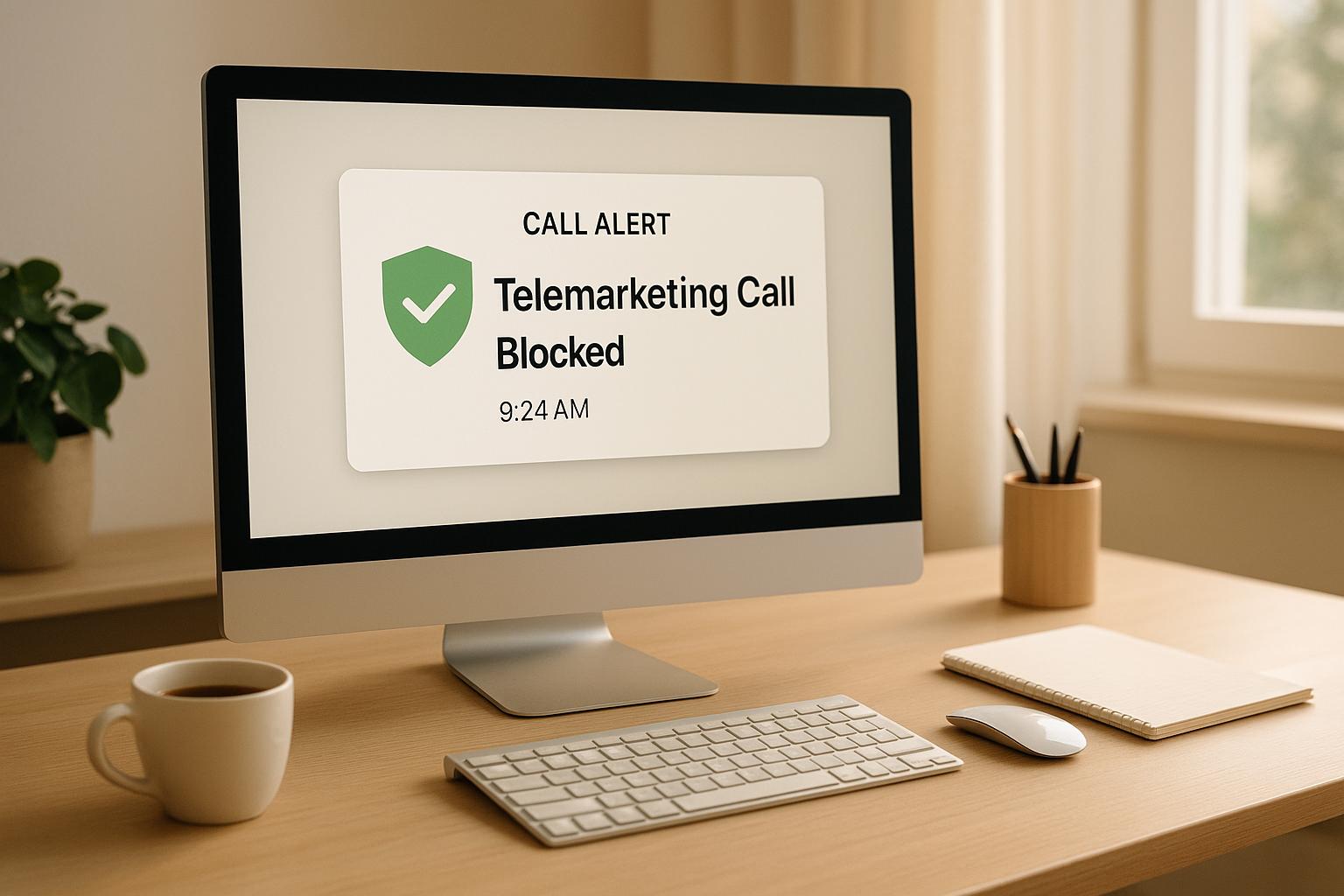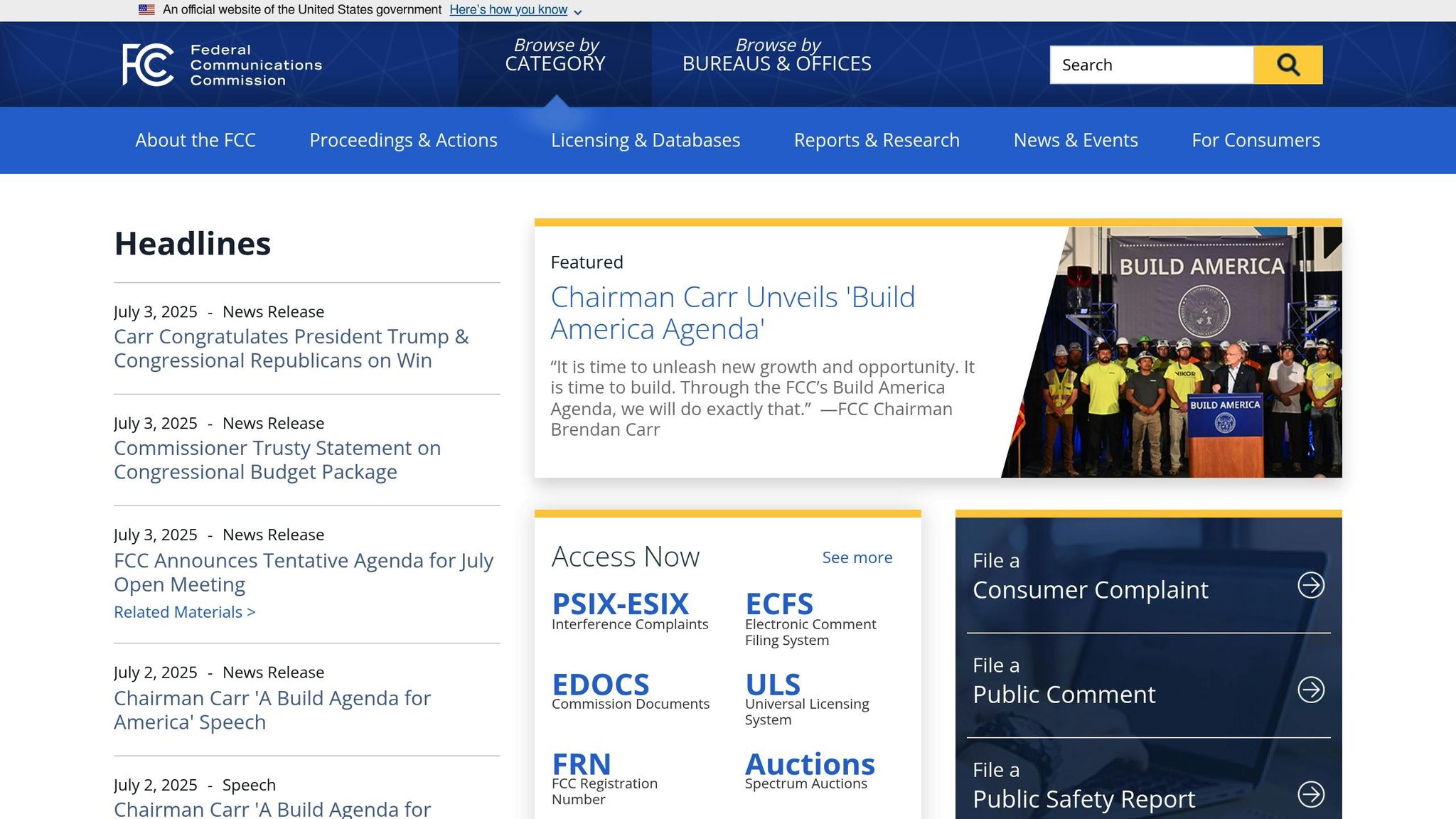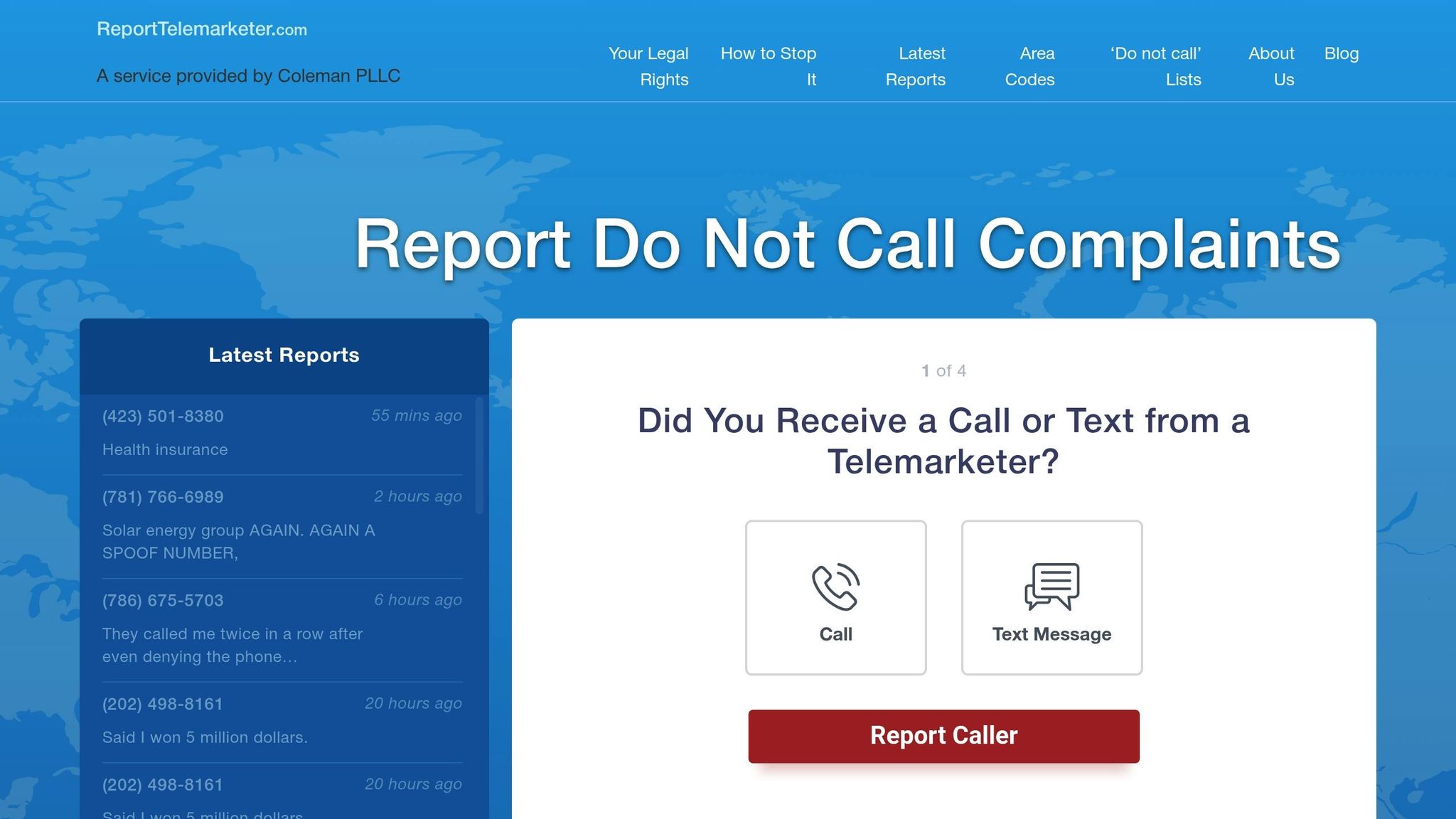
The Telephone Consumer Protection Act (TCPA) protects consumers from unwanted telemarketing by regulating calls, texts, and faxes. It requires businesses to get consent before contacting individuals, restricts calling hours, and enforces the National Do Not Call Registry. Real-time call monitoring systems help companies comply by analyzing calls as they happen, flagging potential violations like calling outside allowed hours or contacting numbers on the Do Not Call list. These systems also track consent, detect risky patterns, and stop problematic calls immediately, ensuring compliance and protecting consumers. By combining TCPA rules with real-time alerts, businesses can avoid fines and build trust with their audience.
Telecommunication Consumer Protection Act (TCPA): Update and Practical Guidance
What Are Real-Time Call Monitoring Systems
Real-time call monitoring systems are tools designed to track and analyze calls as they happen, providing immediate insights into telemarketing activities and compliance with the Telephone Consumer Protection Act (TCPA). These systems play a crucial role in identifying unauthorized telemarketing practices and ensuring businesses operate within TCPA guidelines, ultimately enhancing consumer protection.
"Real-time monitoring for call centers refers to the tools and software which enables managers to oversee and track agent calls as they are carried out. Real-time call monitoring provides managers with call analytics, dashboards, and alerts and tracks speech patterns and acoustics for things like profane language, escalation attempts, compliance violations, and customer sentiment." – The Team at CallMiner
When calls are routed through virtual numbers, details like caller ID, timestamps, call duration, and conversation content are automatically logged into a centralized dashboard. This system alerts supervisors to potential issues in real time, allowing for swift action.
By utilizing speech analytics, these systems generate live transcripts of conversations, giving managers the ability to quickly spot and address problematic situations before they escalate.
Main Features of Real-Time Monitoring
Modern real-time monitoring platforms are equipped to continuously scan calls for compliance markers, such as the use of Mini Miranda language, adherence to Right Party Contact requirements, and avoidance of Fair Debt Collection Practices Act (FDCPA) violations. Additionally, they can detect abusive language and flag risky communication patterns that might lead to regulatory trouble.
Analytics dashboards provide live metrics and detailed call data, offering supervisors a clear view of telemarketing operations. Advanced systems can identify violations by analyzing calling patterns and flagging suspicious activity, such as contacting numbers on the Do Not Call Registry or making calls outside legally permitted hours. These systems trigger instant alerts when potential issues arise.
"Real-time compliance monitoring: Monitor outbound communications in real time to detect and prevent potential TCPA violations before they occur, minimizing compliance risks." – TCN
By integrating these features, real-time alerts not only help businesses stay compliant but also strengthen consumer safeguards.
How Real-Time Alerts Help Consumers
Real-time alerts are a powerful tool for protecting consumers. They allow for immediate intervention when compliance issues arise, stopping problematic calls before they reach individuals. These systems directly enforce TCPA requirements by maintaining live access to Do Not Call registries and internal suppression lists.
With continuous risk assessment, these platforms can identify high-risk calling patterns early, reducing the likelihood of consumer complaints or regulatory penalties. This proactive approach shields consumers from repeated violations while helping businesses maintain compliance.
Real-time monitoring also supports quality control and live coaching. Supervisors can step in during calls when agents deviate from compliance protocols, preventing potential violations and reinforcing adherence to TCPA rules.
The benefits to consumers are substantial. For instance, 89% of consumers who experience poor service will turn to competitors. By catching and correcting compliance issues in real time, these systems help businesses build trust and uphold the protections TCPA regulations are meant to ensure.
How the TCPA Enhances Real-Time Call Alert Systems
The TCPA plays a vital role in strengthening real-time call alert systems by setting clear legal guidelines. These rules provide actionable criteria that help automated systems identify and block non-compliant calls as they occur. By integrating these standards, real-time monitoring systems can act swiftly to prevent violations and protect consumers.
TCPA Rules That Power Real-Time Alerts
Several key provisions of the TCPA serve as triggers for automated monitoring. For instance, the FCC requires prior written consent for prerecorded telemarketing calls to residential or wireless numbers. Real-time systems can verify consent records before a call is initiated, flagging any instance where valid consent is missing. Similarly, oral or written consent is mandatory for autodialed or prerecorded calls and texts to wireless numbers, providing clear benchmarks for enforcement.
Other rules, like restrictions on call times and the 10-business-day window for processing do-not-call requests, also act as measurable triggers. Calls made outside the permitted hours are flagged, and suppression lists are updated immediately when consent is revoked.
"The most complex part is identifying the illegal calls in real time to be able to block them without blocking lawful calls." – FCC
Opt-out signals are another critical trigger. Consumers have the right to revoke consent for robocalls and texts in any reasonable manner, and real-time systems act on these signals instantly to suppress further communications. The financial penalties for violations – ranging from $500 to $1,500 per call – highlight the importance of these proactive measures.
These well-defined triggers not only improve the performance of real-time alert systems but also pave the way for advanced AI-driven call monitoring.
AI and Pre-Recorded Call Compliance
The TCPA also addresses modern challenges like artificial intelligence and pre-recorded calls. According to the FCC, calls using AI-generated voices are classified as "artificial" voice calls under the TCPA, requiring prior consent. This distinction gives real-time systems a clear framework for identifying unauthorized AI-generated calls.
"We believe this definition is consistent with federal and state AI definitions cited in the AI NOI, and tailored to reflect the privacy protections under the TCPA by focusing on AI-generated voice or text calls used to interact with consumers in outbound telephone calls." – FTCattorney.com
Pre-recorded calls, due to their structured nature, are particularly well-suited for real-time monitoring. If such a call is initiated without proper consent, the system can immediately flag it, reducing the risk of violations. Additionally, analyzing call patterns and consumer complaints helps refine detection methods over time.
sbb-itb-a8d93e1
Setting Up Real-Time Alert Systems for TCPA Compliance
To stay ahead in TCPA compliance, setting up real-time alert systems is a must. These systems, built on established TCPA guidelines, help businesses detect violations instantly. This proactive approach not only minimizes the risk of hefty fines but also ensures communication practices remain within legal boundaries.
Setting Up Alerts Based on Call Data
Monitoring key data points like call frequency, consent status, and timing is essential. For example, excessive call frequency or clustering should trigger immediate alerts. Consent verification is equally critical – real-time checks must confirm prior express written consent before any telemarketing call is made.
Time zone monitoring is another vital component. Systems should automatically verify the recipient’s local time to ensure calls fall between the allowed hours of 8:00 a.m. and 9:00 p.m. This ensures compliance with time restrictions based on the recipient’s location.
Managing do-not-call (DNC) lists is an ongoing process. With fines for DNC violations reaching up to $43,792 per infraction, automated systems should frequently scrub contact lists against national, state, and internal DNC records. Considering that nearly 100,000 phone numbers are reassigned daily, continuous updates to identify reassigned numbers are crucial.
Call content analysis adds another protective layer. Systems should distinguish between informational and marketing messages, as each requires different levels of consent. Additionally, it’s important to differentiate between cell phone and landline numbers, as the rules for these vary significantly.
"You want to call people that want to talk to you, that have expressed some level of interest in your product or service."
– Nima Hakimi, Convoso CEO
Systems must also flag missing or incorrect caller ID details. Keeping these systems updated is essential as FCC regulations evolve.
Updating Systems for New FCC Rules

With regulatory changes happening regularly, system updates are critical for staying compliant. For instance, the April 2025 implementation of the Opt-Out Rule required significant system modifications. Paul St. Clair, Head of Compliance at Convoso, explains:
"The new TCPA rules require businesses to honor opt-out requests across communication channels."
– Paul St. Clair, Head of Compliance at Convoso
This rule mandates real-time tracking of opt-out requests, which must now be processed within 10 business days. Businesses need systems that can recognize opt-out requests made through any reasonable method – whether verbal, via text message, email, or even in person. This requires seamless integration between CRM systems, dialers, and communication platforms.
For SMS platforms, configure them to automatically process common opt-out phrases like "stop" or "unsubscribe". Once an opt-out request is received, systems should immediately stop further messages, though one confirmatory message is allowed within five minutes.
"Use an integrated CRM and dialer system that instantly logs and enforces revocation requests across all communication channels (calls, texts, emails)."
– Paul St. Clair, Head of Compliance at Convoso
Looking ahead, businesses must prepare for the FCC’s delayed "cross-channel" opt-out rule, set to take effect in April 2026. This rule will expand opt-out requirements to cover all communication methods, demanding further system updates.
Regular compliance audits have become increasingly important. Systems should automatically review call recordings, text logs, and CRM records to confirm opt-out requests are handled correctly. This helps identify and address compliance gaps before they lead to violations.
Training is another critical area for system updates. Technology should support employee education, ensuring teams can quickly recognize and act on opt-out requests. During calls, systems should guide agents in identifying and processing these requests.
"Synchronize opt-outs across systems to prevent re-contact."
– Paul St. Clair, Head of Compliance at Convoso
With TCPA violations carrying penalties of $500 per call – and up to $1,500 for willful violations – the financial risks of non-compliance far outweigh the costs of proper system setup and maintenance.
How ReportTelemarketer.com Protects Consumers

ReportTelemarketer.com builds on the Telephone Consumer Protection Act (TCPA) by offering consumers a straightforward way to combat telemarketing violations. While businesses focus on compliance, individuals need effective tools to address unwanted calls and texts. This platform bridges that gap, empowering people to take action against telemarketers who violate their rights.
How ReportTelemarketer.com Works
The process at ReportTelemarketer.com is simple but effective, with over 30,000 individuals already benefiting from its services.
- Step 1: You Report
Users fill out a short form on the website, detailing the telemarketing calls or texts they’ve received. Information like phone numbers, call frequency, message content, and timing helps create a clear picture of the issue. - Step 2: We Investigate
The platform’s team uses advanced tools to identify the telemarketers behind the calls. Even when telemarketers hide behind spoofed numbers or complex routing systems, the investigators dig deep, sometimes reaching out to users for additional details. - Step 3: Stop the Calls
Once the telemarketer is identified and found to have violated TCPA rules, legal action is taken. This could involve sending cease-and-desist letters or filing formal complaints to put an end to the harassment.
"As a consumer protection firm, we use the telephone consumer protection laws to stop telemarketers from harassing consumers."
– Stefan Coleman, Lawyer and Founder of ReportTelemarketer.com
The platform’s ability to uncover the identities of telemarketers – who often attempt to stay anonymous – is a cornerstone of its effectiveness.
How Real-Time Alerts Support the Platform
Real-time call monitoring plays a critical role in identifying and addressing TCPA violations. When consumers report calls immediately after receiving them, the platform can capture essential data while it’s still fresh and actionable.
Quick reporting not only helps identify patterns but also strengthens cases. For example, if multiple users report the same telemarketer in a short period, it provides compelling evidence of systematic violations. This timely data collection is crucial since telemarketers often switch numbers or tactics to evade detection.
Real-time alerts also help preserve key evidence, such as call logs and recordings, and track evolving telemarketing strategies. By staying a step ahead of these tactics, the platform ensures robust consumer protection. For users, this means faster resolutions and quicker actions to stop the harassment.
Free Service for All Users
In line with the TCPA’s mission to protect consumers, ReportTelemarketer.com offers its services completely free of charge. This model eliminates financial barriers, making legal recourse available to everyone. Instead of charging users, the platform recovers attorney fees directly from telemarketers once their violations are stopped.
This approach not only ensures accessibility but also aligns the platform’s goals with consumer interests. Since the platform is only compensated when telemarketers are held accountable, they are motivated to pursue cases aggressively. Consumers may also receive compensation, with potential payouts of $500 per call under TCPA provisions.
Additionally, the free service model safeguards consumer privacy. With no financial transactions involved, users don’t need to worry about creating additional data trails. By removing cost concerns, ReportTelemarketer.com ensures that everyone has the opportunity to stand up against telemarketing violations, leveling the playing field for those who might not otherwise afford legal representation.
Conclusion: Protecting Consumers with TCPA and Real-Time Alerts
The Telephone Consumer Protection Act (TCPA) lays down a solid legal framework for safeguarding consumers from unwanted telemarketing calls. When paired with real-time call monitoring technology, it becomes an even more powerful tool, offering a proactive way to address violations as they happen instead of reacting after the damage is done. This partnership between legal protections and technology creates a dynamic defense system.
Real-time call alert systems act as an early warning system, immediately flagging potential violations. They also help pinpoint calls that may lack the consent required under TCPA regulations, ensuring tighter compliance and better consumer protection.
This layered approach works because each element complements the other. The TCPA sets clear rules, while real-time monitoring delivers immediate action. Together, they form a robust shield against telemarketing abuse, adapting to the ever-changing tactics of telemarketers.
With telemarketing strategies evolving, especially with the rise of AI-generated calls, this integrated system becomes even more vital. The FCC’s recent focus on these emerging technologies underscores the importance of updating real-time alert systems to address new threats effectively. Staying ahead of these developments ensures that consumer protection measures remain strong and relevant.
For consumers, the message is clear: you’re not alone in dealing with intrusive telemarketing. By understanding your rights under the TCPA and using tools like real-time monitoring and free reporting services, you can actively block unwanted calls and report violations. Every blocked call and reported infraction contributes to a larger effort to hold violators accountable.
Ultimately, success depends on informed and proactive consumers who take advantage of the tools available to protect themselves and support a collective stand against telemarketing violations.
FAQs
How do real-time call monitoring systems help businesses follow TCPA regulations?
Real-time call monitoring systems play a crucial role in helping businesses comply with the Telephone Consumer Protection Act (TCPA). By enabling supervisors to actively oversee calls as they occur, these systems allow businesses to catch and address potential issues – like unauthorized autodialed calls or robocalls – before they turn into violations.
These tools help ensure that businesses follow key TCPA requirements, such as respecting the Do Not Call (DNC) list, securing proper consent for calls, and maintaining accurate caller ID information. With continuous monitoring, companies can minimize legal risks, avoid hefty fines, and uphold responsible communication standards.
How does the TCPA work with real-time call alert systems to prevent telemarketing violations?
The Telephone Consumer Protection Act (TCPA) lays out clear guidelines to shield consumers from unwanted telemarketing calls and texts. Real-time call alert systems are designed to align with these regulations, ensuring telemarketers operate within the law.
Under the TCPA, businesses must obtain prior express consent before calling or texting mobile phones. Additionally, telemarketing calls are restricted to specific hours – no earlier than 8:00 a.m. and no later than 9:00 p.m. in the recipient’s local time zone. Another important rule requires systems to automatically release a consumer’s phone line within five seconds if a violation occurs. These rules are in place to limit disruptions and prevent unauthorized practices.
By incorporating these TCPA requirements, real-time alert systems help protect consumers while holding telemarketers accountable to the law.
How can businesses use real-time alert systems to handle opt-out requests and stay compliant with TCPA regulations?
To comply with the Telephone Consumer Protection Act (TCPA) and efficiently handle opt-out requests, businesses should consider using real-time alert systems. These systems can instantly process opt-outs across multiple communication channels – calls, texts, and emails – ensuring that consumer preferences are updated without delay. By doing so, businesses can meet the required 10-business-day deadline for honoring opt-out requests, minimizing the chances of violations and potential penalties.
In addition, leveraging automated tools like AI-driven monitoring can further streamline compliance efforts. These tools can proactively track opt-outs and ensure that all outbound communications cease immediately once a consumer opts out. This not only helps businesses avoid legal complications but also reinforces their commitment to respecting consumer rights under TCPA.